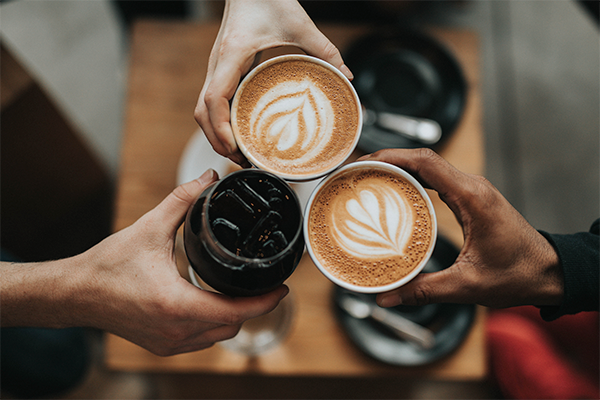Just about everyone has a flood of opinions about caffeine. Even the word itself tends to create a dichotomous perspective of either strictly good or bad, or good for your health versus a health risk.
For most people, caffeine is a key element in their decisions on tea versus coffee, green versus black tea, herbal versus bush-harvested teas, etc. Either you drink it or you don’t, mainly on the basis of you “know” it’s bad for you or it’s fine if you stick to recommended limits.
If caffeine is a main choice factor for you, it’s worth shifting your focus from what we call the “teaspoon view” of caffeine to the “molecule view” instead.
The teaspoon view is centered on how much caffeine you ingest and what side effects and benefits that can bring.
The molecular view looks at the how – not the how much: how does caffeine actually work in your body? (1)
The Teaspoon View of Caffeine (How Much Caffeine)
Teaspoon discussions of caffeine mostly center on how much: what is the caffeine content in a cup of coffee (100 milligrams, on average), how much is a sensible limit (400 mg a day), how much there is in a serving of green tea (20 or so, with a range of 15 to 75 or more), black tea (60-ish), and so on.
There’s a general assumption that less caffeine is better than more, but also that more means a richer fullness of taste and larger energy boost.
If you’re looking at caffeine from just this perspective of counting the milligrams, how do you account for the different impact that various caffeinated beverages have on you?
Things like differences in taste, energization, wakefulness, sleeping patterns or crashing with sweating and increased blood pressure. You might assume these variables (and possible negative effects) must all be related to how many milligrams of caffeine you’ve ingested.
But they don’t.
If you’ve enjoyed both tea and coffee, you know they make you feel quite different. You can vary the types of tea – greens, blacks, oolongs, puehrs, and whites – and adjust their brewing time and temperatures or their content in milligrams. Coffee drinkers can try out permutations of coffees, espressos, lattes, robustica, arabica bean, cold brew, cappuccino.
You’ll get plenty of variations in taste, but even though the caffeine is the same basic compound, this one tea-coffee difference holds:
Coffee stimulates, Tea calms.
Why? It’s all about the busy molecule.
The Molecule View of Caffeine (How it works in your body)
Think of your body as a biochemical Internet. Your brain has a hundred billion neurons, which are electrically and chemically stimulated to send signals to each other. (2) The signals activate, transform, build or block all our physical and mental activities.
It’s receptors that are key to caffeine’s effects. The interaction is most marked in the very core of its everyday role in your routine: wakefulness and sleepiness. It’s located in your central nervous system and is updated by neurotransmitters that generate adenosine.
During the day, receptors gradually release this chemical that slows down nerve cell activity. As a result, you get sleepy and eventually ease into a good night’s rest.
Caffeine is a kind of hacker attack. It evolved naturally in a few plants, in order to ward off predators. (3)
It developed a molecular structure that is similar to that of adenosine to the degree that it can lock into its receptors in your brain. It doesn’t interfere with the receptors – but blocks them, taking up the space of the molecules that would otherwise lull you to sleep.
Effects of Caffeine
So, instead of getting the calming effect of adenosine, caffeine causes nerve cells to speed up, blood vessels to constrict and the pituitary gland senses that some stress emergency is coming. It responds by boosting adrenaline. (4)(5)
Additionally, the liver starts releasing sugar into the bloodstream to provide extra energy. Muscles tighten up, ready for action. Heart rate increases. Dopamine receptors are able to operate at increased rates; this is commonly known for its increasing a sense of pleasure and stimulates us to carry out enjoyable activities; it’s released when we eat, for example, boosting appetite.
In humans, this is the process by which caffeine affects alertness, improving many cognitive functions, and keeping tiredness at bay. For bugs and other plant predators, it’s a massive overload assault on their nervous system that paralyzes and even kills.
Caffeine as a Drug?
For humans, caffeine does not fall into the formal definition of addiction but has marked effects of tolerance and withdrawal. It is a bitter alkaloid, like nicotine and also heroin. It’s water-soluble and passes through the blood-brain barrier easily and quickly.
That’s key to its impact as a stimulant. Most substances are blocked from penetrating the membrane of blood vessels that protects the central nervous system (CNS). Caffeine, however, passes directly to the brain, where it generates a milder range of the psychotropic – mood-altering – effects of addictive drugs such as heroin. It has a very short half-life in your body. 99% is absorbed completely in 45 minutes.
Yes, caffeine is a drug. You build a tolerance to it because, over time, your body fights back by developing more adenosine receptors to maintain an equilibrium. It then needs more caffeine to keep them blocked. When you cut your caffeine intake, there will be around 7-12 hours of caffeine withdrawal symptoms that usually ease within a week. (Some of the science in this area is conjectural rather than proven.) (6)
Now that we know how caffeine works, there’s still the question of why coffee stimulates but tea calms. Even though the chemical is the same in both drinks, the differences are marked. They reflect theanine binding.
The L-theanine Effect
You can read more here about l-theanine’s calming effects, physically apparent in brain waves. It also creates a relatively newly-categorized type of taste, umami, that adds a sweet brothiness noted in some green teas.
As with caffeine, l-theanine passes easily and quickly through the blood-brain barrier so that it affects moods, very positively. The preliminary scientific findings are that these are not marked in isolation, but rather the combination of caffeine and theanine produces an alert calmness.
L-theanine is an antagonist of glutamate receptors, increasing serotonin and dopamine in regions of the brain. The caffeine boost is preserved but complemented by theanine’s wakeful relaxation. The flow of the caffeine is slowed along the neural pathways.
L-theanine is noted for taking the edge off CNS stimulants. It’s a relaxing agent and smoothes out the jolts and crashes associated with caffeine. This is why the caffeine in tea is not noticeable compared to coffee. The theanine glutamate binding plus its calming and stress-reducing impacts on mood are slower in tea and may be less appealing for coffee lovers who want the fast kick rather than the slow mellowness. (7)
Summary Thoughts
The teaspoon view of caffeine is limited and easily leads to bias. It is most useful in providing broad guidelines about amounts and limits in daily caffeine consumption and the relative merits of green and black teas. It helps factor in issues of personal body profiles, including weight and genetics, pregnancy, and nutrition.
Obviously, the amount of caffeine you consume is always an issue. In passing, 80 cups at a single time will kill you and there are risks of caffeine overdose in high dosages, mainly from caffeine pills or abuse of energy drinks.
At the same time, the teaspoon view too easily encourages biased misinformation and overbroad opinions presented as fact. The molecule view provides more rigor and reliability that doesn’t necessarily conflict with this but sometimes disputes it.
For instance, one commonplace piece of folk wisdom is that caffeine dehydrates you. Nonsense – that’s scientifically impossible.
Here’s a summary of insights from the molecule view that adds to those of the more general teaspoon view:
| Belief that caffeine… | What the science reliably shows | Messages for your choosing tea, coffee, herbals |
| Is a drug | Yes, it is. It’s psychotropic, affects mood, creates tolerance and can produce withdrawal discomfort. | Consider occasional but regular detoxing.
If this is a worry for you, drink quality herbal teas. |
| Helps concentration and alertness. | Yes, the evidence is wide-ranging and solid. This is a major benefit of caffeine. | If you want a fast, pick-me-up impact on your mental performance, go for the coffee or black teas. |
| Disrupts sleep | Yes, by binding to and blocking to adenosine, caffeine interferes with just about every aspect of sleep patterns. | Make adjustments to what and when you drink tea or coffee to accommodate the 4-6 hour typical ingestion to excretion. |
| Dehydrates you | Nonsense. At most, it increases urination a little when you have not been taking in caffeine for some period. | Drink tea as you would water. |
| Is higher in coffee than tea | The averages are just that and do not capture range, brewing, etc.
The dynamics of binding are the same. Don’t get hung up on the numbers. Many are out of date and largely unreliable. |
Stick to the broad limits of 400 mg as safe daily dose.
Assume 40 and 60 mg per cup for greens and black teas and 100 mg for coffees. |
| Is lower in green tea than black, oolong, white | On average, yes. But not enough to make much impact on the effects on mood, physical reactions, etc. (White tea often is highest in caffeine because the buds are young and nutrient-rich) | Don’t drink cheap, mediocre green teas because of the caffeine differences. |
| Is affected by genetics | Growing evidence of some impacts.
Is safe for most people. |
Trust what your body is signaling. |
| Aids wellness in specific areas | Mostly circumstantial evidence that is growing and growing.
In general, green tea benefits are well-established. Black tea stands out for cognitive performance. Coffee benefits less studied and documented. |
Suggest that you focus on the wellness first – gut health, mood, sleep, etc. – and then the specific beverage to choose.
Green tea seems the best overall option, then oolongs and black teas. Coffee lower benefit evidence to date. |
| Works in the body the same way for tea and coffee | No. | Understand the dynamics of binding. If they came as a surprise to you, keep in mind that there are a lot more to be uncovered.
Add the molecular view to your knowledge base and decision criteria. |






